Search results
4 results found.
4 results found.
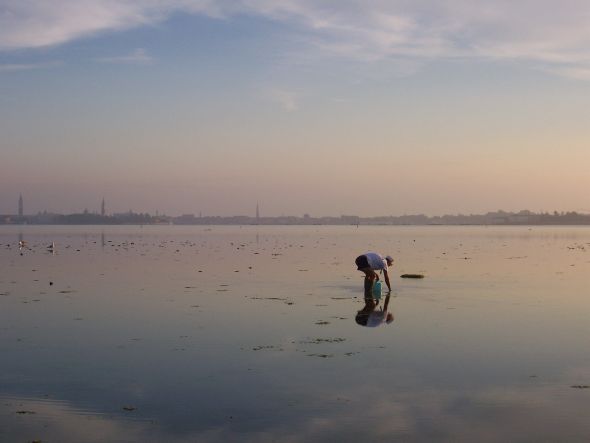
This is an unusual step for me, but I think it’s worth it. Even though I don’t place much trust in the power of petitions, maybe this time it will be different.
In any case, I’d like to inform you of one which has gone from 700 to 20,000 signatures and counting in about ten days. I think that means something.
“Gruppo 25 aprile” is a new group of Venetians and Venice-lovers which is concentrating its efforts on stopping the digging of the “Canale Contorta.” Its reasons are shared by many scientific and environmental experts, not to mention a huge percentage of everyday Venetians.
Once the subject of the big cruise ships and their potential to damage Venice became one of the hottest debates and power struggles of the year, the need for finding an alternate route from the Adriatic to Venice obviously became paramount. My own opinion is that any “cure” they find will be worse than the “disease” (i.e., the ships in the Bacino of San Marco) — or, as the Venetians put it, el tacon xe pezo del buso (the patch is worse than the hole).
Many solutions have been proposed, but only one had the political muscle behind it to get itself officially considered by the “Comitatone” (“Big Committee”) in Rome, which had the power to decide yes or no. That “solution” is the dredging of the Canale Contorta.

Thanks to a calculated maneuver by its promoters, the meeting at which the decision was to be made was held in August. (“August” is Italian for “vacation.”)
As Marco Gasparinetti, the coordinator of Gruppo 25 aprile, explains (translated by me from the Gazzettino):
“The decision of the Comitatone on August 8 was a summer blitz with which they hoped to surprise a city on vacation. But the city is fed up with being expropriated from the decisions which concern it, and this time is going to make its voice heard.”
The political vacuum in Venice since the government fell on June 4 has at least one positive aspect, and that is that finally there seems to be some possibility that the voices of Venetians might be heard somewhere beyond their living rooms and favorite bars. Yes, there is chaos in almost every aspect of daily life here now, but the fact that essentially only one man is in charge — Vittorio Zappalorto, the Commissario who is temporary governor — means that the city is less strangled by the political and bureaucratic tentacles of the past 20 years. It’s as if — to try another metaphor — a colossal dose of drain cleaner has ripped through the city’s emotional and civic pipes.
Back to the Canale Contorta. It may not be too late to stop it. Therefore Gruppo 25 aprile has created a petition addressed to Prime Minister Matteo Renzi, as well as all the ministers concerned (Environment, Infrastructure and Transport, Culture, etc.) urging them to withdraw the hasty approval of what it (and I) regard as a catastrophic move, the last nail in the coffin of the lagoon after the drastic effects of the MOSE floodgates, not to mention the Canale dei Petroli (“Petroleum Canal”), dug in 1969.
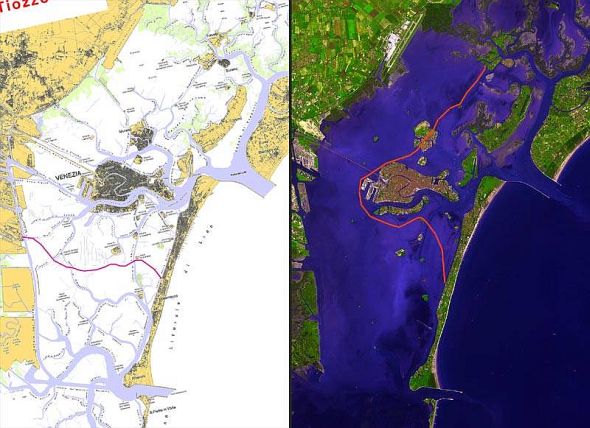
The page connected to the link above shows a map (left) from the 1980’s which outlines the major and some minor natural channels (ghebi) which used to cross and re-cross the lagoon. It represents a complex biological realm which the effects caused by the Canale dei Petroli, in 40 years, has done much to destroy, as shown by the NASA satellite image made in 2002 (right). Do you see ghebi? I see just a broad, anonymous stretch of bottom. That’s what the fish see, too.
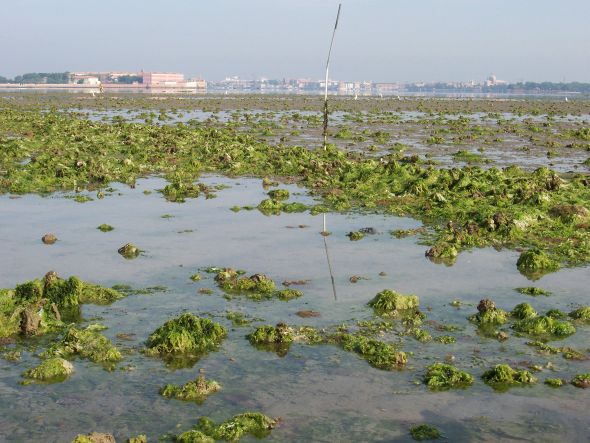
Here is a section of a brief but pointed piece by Tom Spencer, reader in coastal ecology and geomorphology at the University of Cambridge, and director of the Cambridge Coastal Research Unit:
Coastal lagoons are transitional environments between fully terrestrial and fully marine conditions; in the absence of direct human intervention, their long-term tendency is to infill with sediments. Over the centuries, the Venetian Republic was instrumental in maintaining this vital yet delicate land/sea balance, starting with the huge undertaking to divert the main rivers in the 16th century and stop the region from silting up altogether.
Since that time, however, historical and near contemporary records of changing patterns of lagoonal topography and water depth; tidal currents; and sediment transport from the lagoon to the sea all show unequivocally that the current lagoon is moving in the opposite direction, becoming a downward-eroding, sediment-exporting system. It is thus on a trajectory that will turn it into a fully marine bay. That this process is well underway is evidenced by the appearance of plant and animal species in the lagoon that are characteristic of marine environments.
We may argue about the velocity of this trajectory but the evidence for such a trend, clearly related to a whole series of human interventions from the late 18th century to the present, is not in doubt. As wave height and tidal flows are strongly influenced by water depth, such a shift has critical importance for the sustainability of the historic core of Venice itself. If we drill down into the detail behind this general trend, it is clear that the excavation of two large canals (Canale Vittorio Emanuele, around 1925, and Canale Malamocco Marghera, around 1969) produced strong transversal currents across the original tidal network, with consequent siltation of channels and erosion of adjacent shallows.
There is one simple question that needs to be answered. Can we be assured that the large-scale excavation of the Canale Contorta will not have the same effect and not give the Venice lagoon a further shove in the direction of yet more environmental degradation and urban vulnerability?
The petition asks the national government to reconsider all the proposals. That seems like an extremely modest request.
The petition can be signed online. Here is the link explaining their position, with the possibility of signing. (“Firma” means “signature.”)
Or, you can copy and paste:
http://www.change.org/p/stop-the-plan-to-dredge-the-maxi-canal-contorta-in-venice-before-it-s-too-late
If anyone might be tempted to suppose that Venice can be happy and healthy in the middle of a maimed and deformed lagoon, that person should consider this: That the water through the Canale Contorta will enter or leave the lagoon with a force and a quantity that will endanger the city to a degree that the biggest cruise ship could never dream of.

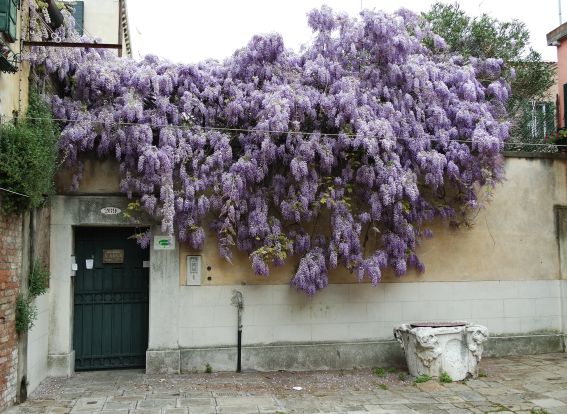
“Cretinate” (kreh-tee-NAH-teh) are actions or statements perpetrated by one or more cretins — a far too useful term in these parts, and one I’m sorry doesn’t exist in English.
But maybe it’s not that there are so many cretins here. Maybe there are lots of highly intelligent, profoundly sensitive, extremely kind and rich people who just happen to say cretinous things. If so, there are still too many of them.
A few days ago we heard the latest of an infinite string of fantasies stated as facts by Paolo Costa, the president of the Venice Port Authority. He gives every sign of being a born believer in the inherent importance and value of Mastodontic Projects, as they put it here, because he has spent the last few years pushing ferociously for approval for the excavation of the Contorta Canal to bring the big cruise ships to the Maritime Zone by way of the lagoon, and not by the Giudecca Canal.
Apart from whether or not this would be a smart move for Venice and its economy (read: keep the port working at full speed), the canal itself has been recognized by an array of environmentalists and even politicians as being enormously damaging to the lagoon ecosystem. (May I note, once again, that the lagoon is also a UNESCO World Heritage Site, a fact which apparently is difficult to remember, seeing how casually everybody goes rampaging around doing whatever they want, though if harm were done to the city to the degree that it’s done to the lagoon, the world outcry would resemble several sonic booms).

I’m coming to the cretinata, uttered by Mr. Costa. He has uttered many since the subject of banning the big ships has been current. The reason he utters them is because it appears to be his heart’s desire to be involved in a Mastodontic Project, seeing as he missed out on the riches lavished on everyone involved in the last one, which is MOSE.
Actually, I don’t know that he missed out. Perhaps he got his share that time around, and is determined to have a reprise.
Whatever the case may be, no Crusader ever made a vow that could match the vow he seems to have made to himself to get that @#*$%! canal dug.
So where’s the cretinata? Here it is:
“The Contorta Canal is the only intervention which can save the lagoon and the jobs of the cruise business.”
First, it can’t be the “only” intervention” that could be effective. There are a number of alternatives which are struggling to be considered, pushing frantically against the inert bulk of the Contorta proposal. To be accurate, it is the only intervention which has the active interest and support of Mr. Costa, and he is applying pressure for its approval by every means known to humans. After all, sheer dogged perseverance finally got the MOSE project approved, although it took 30 years. So it ought to work just as well for this project. That seems to be the approach he’s taking.
In my opinion, saying that something or someone is the “only” one of its kind, when that just happens to be the thing the speaker wants, is a statement more often made by young, distraught children than mature, responsible adults. It sounds fishy to me.
Second, I have never heard anyone except Mr. Costa hazard the statement that the excavation of the new canal would “save the lagoon” (though he doesn’t say from what). I totally understand his desire to keep the port humming, but his opportunistic addition of saying the canal will “save the lagoon” is like telling a woman “By the way, you’re beautiful” when you’ve just asked her to lend you $500.
Many Venetians have long been aware that the lagoon needs saving (from the voracious motondoso, from devastating illegal clam digging, and from the incessant erosion exacerbated by the Petroleum Canal — another Mastodontic Project!). I didn’t realize that digging a new canal would be a positive step in any direction except more erosion and more environmental degradation.
Since Mr. Costa has never made anything resembling an environmentalist statement, I have to assume that “saving the lagoon” is Costaspeak for “doing what I want.”
Here endeth the first cretinata.

Interlude: I used to know a little boy who, at the age of about 2 1/2, had already grasped that saying that he wanted something didn’t inspire the desired response from his mother. So he cleverly switched to saying “I need it.” That little boy did not grow up to become the President of the Port Authority; perhaps he was a cousin.
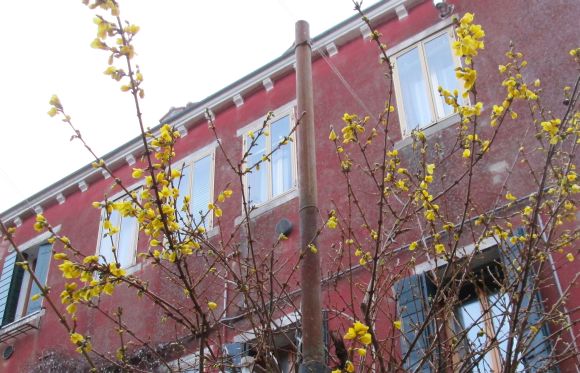
On to the next cretinata, which comes from the Princess Bianca di Savoia Aosta, quoted in “An Insider’s Guide to Venice” in the Wall Street Journal a few days ago.
I admit that statements from people whose names start with Princess (or Defender of the Faith, or Conquering Lion of the Tribe of Judah, or Knight Commander of the Order of St. Gregory the Great) get attention.
Having a fancy title doesn’t necessarily mean that you know things, but it does mean that your statements will probably be taken as true. Such as the Princess’s following remark:
“VENETIAN MOPED // Brussa IS Boat. Rent a “topa,” a zippy four-meter boat, at Brussa, to go for a relaxing and fun spin through the canals before heading out into the lagoon. It’s not as intimidating as it sounds—locals use the topas like mopeds.”
Words such as “zippy” and “spin” give the impression that the canals, like the city itself, are here mainly for entertainment and diversion, just one big amusement park with peeling palaces. They don’t give any hint of the reality — that the canals are narrow, crowded, and full of boats doing real work which take up space and aren’t especially accommodating to high-spirited gilded youths out for a little run about town before drinks at the Cipriani, or wherever.
Second, “locals” do not use the topas like mopeds. “Locals” have their own boats, usually, or have friends with boats. Topas are for special jobs or projects — most often like work — which usually do not involve either zipping or spinning.
Third, apart from being awkward and difficult to perform, zipping and spinning would be a challenge to do without breaking the speed limits, which are now being more strenuously enforced since the new traffic regulations went into effect. The only boats I can think of whose zipping or spinning is overlooked are the fireboats and the ambulances.
“Like mopeds” implies speed, agility, and quantity, like the swarms in Rome and Florence. There is no craft here which could be compared in any way to a moped. Not one.
Which leads me to conclude that the princess either doesn’t know what a topa is, or what a moped is. It would be like me saying “Lapps use reindeer-sleds like mopeds,” or “Somalis use camels like mopeds” or “New Zealanders use dolphins like mopeds.”
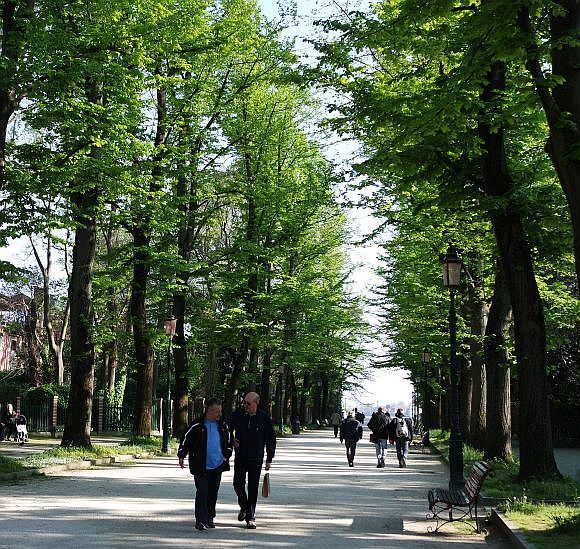
But I’m being too serious, it’s one of my major defects. So let me offer a more effervescent cretinata, perpetrated by two incredibly clever employees of the ACTV who went fishing on company time.
Connoisseurs of lagoony creatures know that this is seppia (cuttlefish) season. Even if you don’t happen to be a connoisseur, all you have to do to realize the season is on is either go to the Rialto to see what’s on sale, or wander along your fondamenta-of-choice in the morning or evening (or night) to peruse the men who are standing there with their fishing rods and nets and ink-stained buckets. The Zattere, the Riva degli Schiavoni, the Fondamente Nove, and even scabrous old Tronchetto are all excellent places to snag some seppie.
Unless you’re supposed to be doing something else, like work.
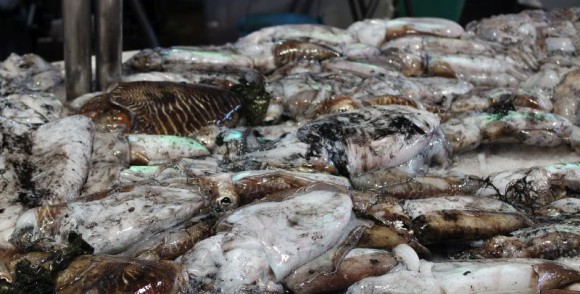
On the evening between Tuesday and Wednesday, two employees of the ACTV were on duty at Tronchetto in the area dedicated to the ferryboat from the Lido, and one of their tasks was to keep an eye on things in general and to make sure that nobody was doing anything near the landing-stage that could create problems for the ferry.
It would appear that these two zealots decided that seppia-fishing on the nearby fondamenta was likely to create problems for the ferry (actually, for their own fishing plans), so they wasted no time in banishing the fishermen from the fondamenta.
Shortly thereafter, the banished fishermen, watching from a nearby fondamenta, noticed the two zealots pulling out their own tackle and beginning their own great seppia-hunt from the now-liberated good spot.
This was unwise.
The banished and extremely annoyed fishermen proceeded to phone the Provincial Police, who are responsible, among other things, for checking fishing licenses. Before long a patrol-boat appeared, and the officers showed as much zeal in the execution of their duty as the two ACTV bullies had done in theirs.
The officers took away their traps, their fishing lines, and their seppie. The officers also searched their cars, and fined them for fishing without a license.
The officers then reported the incident to their employers, who were probably less concerned about the fines than they were about the fact that their two trusty agents had been amusing themselves in an off-duty sort of way when they were, technically speaking, very much on duty.
Moral: Don’t antagonize seppia-fishermen? That’s a good one. Another good one would be: Don’t behave like a cretin.

In spite of all this tomfoolery, spring is proceeding in its appointed course, and I am loving every aspect of it.
The trees are fully-leaved, as of about ten minutes ago, and the greenery still looks as fresh as salad. Trees are blooming according to plan: the white-flowered plums have come and gone, followed by forsythia and cherry and double-cherry, and now the wisteria is slowly being transformed from purple blossoms into green fronds. Random flufflets of cream-colored spores float away from the poplars, and the redbud (called “Judas-tree” here) is making up in color what it lacks in size.
A few days ago I smelled cut grass for the first time this year. It’s a moment that’s almost as enchanting as hearing the blackbirds at dawn. And today I got a bonus: Someone had cut a stretch of herbage which contained chives (here called “sultan’s beard,” or “friar’s beard), and the fragile oniony scent was wafting faintly away. It will be gone by now.
This is one of those perfectly poised moments, when the air is still cool but you can feel the sun’s warmth (if the wind isn’t blowing). At any time of the day the streets are full of people dressed for every possible temperature: There are couples in T-shirts and even tank tops and shorts, and at the same time there are people in trim down jackets or woolen coats. Those with bare arms don’t seem to be cold, and those wrapped in feathers don’t seem to be hot. It’s extraordinary.
Which means that we are approaching one of the tiniest hinges of the season: The moment when everyone ceases to move from the shady to the sunny side of the street, and begins to move from the sunny to the shady side.
When that happens, I declare summer officially open for business.


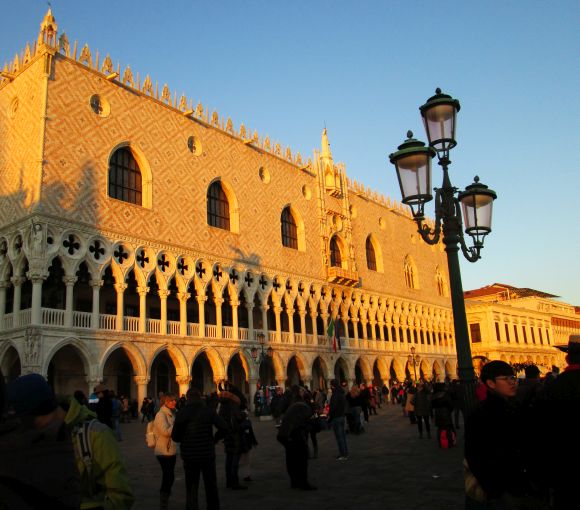
One thing that everybody loves about Venice is that it seems so old. Of course, it is old. It’s kind of like a Byzantine/Renaissance/Baroque/Neo-Classical Lascaux Caves, except that it’s inhabited.
I pause to say that I know there are at least 14 continuously inhabited cities in the world that are far, far older than Venice. I was just making the point that many visitors are struck with astonishment at the fact that Venice was ever created, an emotion I believe the cave paintings also elicit. But I’m getting off the point.
One thing that makes it feel old when you’re living here is the endless cycle of the same old things, and when I say that I don’t mean the Befana (with its utterly predictable brief annual cluster of highly-charged articles about the dangerous effects of the air pollution caused by the bonfires’ smoke), or the feast of the Redentore, or other celebrations.
By “same things” I mean issues that just keep coming up, that continue to be transformed in a shape-shifting way by assorted groups, interested parties, and random changes of circumstance, but that never get settled. Even in the rare instances when a problem appears to have been resolved, before long we discover that it has spawned new problems. And the cycle begins again.
In the few days since 2015 began, the Gazzettino has filled its pages with a new crop of the old. Such as:
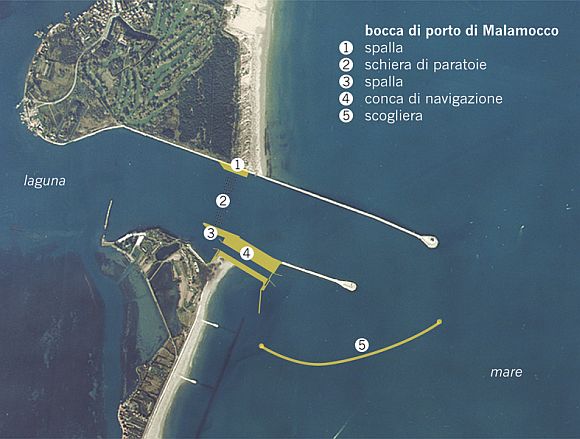
MOSE: No, this time it’s not about the gates themselves, nor about the billions that were stolen to pay off its many participants, collaborators, and well-wishers. Now it’s about the conca, or basin (#4 on the image above), which was dug at the inlet of Malamocco to permit the passage of ships on the occasions when the gates are raised.
For one thing, it’s too small.
It has been designed to accommodate ships up to 280 meters (918 feet) long and 39 meters (128 feet) wide. These dimensions are already too small for the largest cruise ships, the ones that certain groups want to compel to enter the lagoon by way of Malamocco instead of by the Bacino of San Marco. So a mega-cruise ship wanting to come to Venice would have to hang around outside in the Adriatic until the tide turned and the gates were lowered, to let them continue with their plan to unload thousands of passengers and take on more. Having to delay entry sounds like a new problem has just replaced the old.
But it gets worse. The fundamental problem isn’t size. It’s the positioning of the scogliera (skoh-LYEH-ra), or protective barrier, in relation to the basin. Stick with me here, because in the world of engineering “oops!” this is kind of special. And whatever you may think about cruise ships, we now have to consider the needs of real grown-up working ships that haul containers and petroleum and grain and coal (for the power station just on the edge of the mainland); these are ships for which time really is money.
The curve and position of the barrier built to shield the basin from wild stormy water (the kind you might well have if there is an exceptional acqua alta underway) makes it difficult — in some cases, perhaps impossible — for even smaller ships to navigate themselves into a perfect straight line to enter the basin.
“About 2,000 vessels (note: That’s nearly six per day) enter and exit the lagoon each year,” said Alessandro Santi, president of Assoagenti Veneto, the maritime agents’ association. “Of these, at least 350, in the current state of things, would be prevented from entering the basin.” They’d have to wait outside till the tide turned and the MOSE gates were lowered to allow them to enter by the usual channel.
Solution! Construct an additional rubber barrier (I have no further details) against which the ships could lean — a sort of fulcrum — to help them position themselves to enter the basin. I’m referring to the ships which can, in fact, enter the basin, which as you see isn’t going to be all of them.
Projected cost: 15 million euros ($17,669,900). That’s one heck of a patch.
Speaking of cost, the news has just come out that the completion date for MOSE has yet again been postponed. It is currently predicted to be finished in mid-2017, and will cost an additional 2 billion euros ($2,355,980,000). Unless it turns out to cost more, of course.
So why is this an old subject? Because it’s yet another aspect of a project that wasn’t planned correctly, but construction just went merrily along anyway, and now everybody is having to find ways to resolve problems that didn’t ever have to exist.
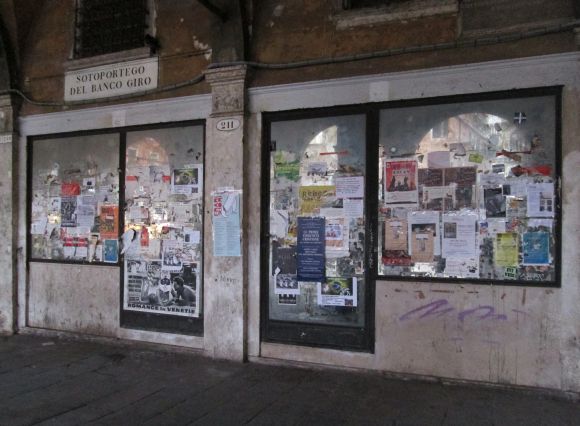
DEGRADO: The terse but expressive and useful term degrado (deh-GRAH-do) means “degradation,” and it finds innumerable uses. And I will keep this entry short because the subject deserves a post all of its own, if I could find the strength.
Degrado is a hydra-headed monster composed of graffiti, broken pavements, disintegrating nizioleti, and now strata of aging posters stuck up all over walls. The city of Venice, and myriad individuals, put up these pieces of paper with or without permission, and these announcements of all sorts of events, needs or offers stay there because once the moment has passed, who cares?
The city says it cares, and since 2012 has spent 856,000 euros ($1,008,360) to pay a private company named A.R. Promotion to affix posters and also to strip away the accumulated crud. But evidently the announcements breed at night and produce more old posters, or somehow the private company isn’t keeping up. Or perhaps even starting, who knows?
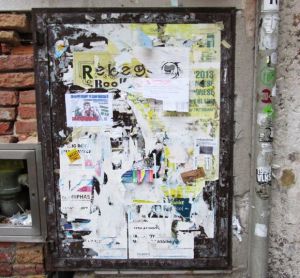
Breakdown of payments made: At the end of 2012 A.R. Promotion won the bid to do this work for one and a half years for 456,000 euros. A few years later, the same company got the job for about two years for 400,000 euros. The age of some of the posters indicates that in either one or other of these periods, the company somehow didn’t catch everything.
Let me say that having to hack away layers of gummy paper over a period of years does not speak well for the paper-hangers. Because while one could criticize the ability of A.R. Promotion to remove paper, one could much more justly criticize the cretins who put up the pieces of paper in the first place.
But back to the subject of payment for services rendered, or not: Cecilia Tonon, president of the volunteer group Masegni e Nizioleti, has raised her hand to ask why the city is paying for a service which evidently isn’t provided, when squadrons of members have turned out more than once to do a large amount of this very work for free. (I participated in one clean-up project, which I’ll write about another time.)
No answer has yet forthcome.
Intermission: News from the trial of the Indian couple who murdered their Iranian roommate, Mahtab Ahadsavoji, and dumped her body in the lagoon. The Indian girl has been identified as the culprit, and has been sentenced to 17 years in prison. Her boyfriend got a smaller sentence because he merely helped dispose of the evidence. Appeals will drag on.
BUDGET: For years now we’ve had to listen to the municipal choir singing the Anvil Chorus, financial version, whose refrain is “No ghe xe schei” (there is no money).
We found out last year that the reason there was no money was because it had all been gift-wrapped and given to politicians and businessmen involved in the MOSE project.
So now there really is no money.
After working his way upstream through heavy fire from outraged city employees facing drastic cuts, attempting to make the budget balance in some miraculous way (“miraculous” meaning “money from Rome”), the emergency governor, Vittorio Zappalorto, has had to say it isn’t working. The city is 60 million euros ($70,855,800) in the hole.
“The situation is unsustainable,” he said. “We’ve reached a point of no return, The next mayor is going to have” (I freely translate) “one hell of a hideous job.” The Casino’, once an endless font of funds, is also now crouching over its begging bowls. The sale of palaces is almost the only option for raising money, but so far they are being sold at slashed, fire-sale prices, or not being sold at all.
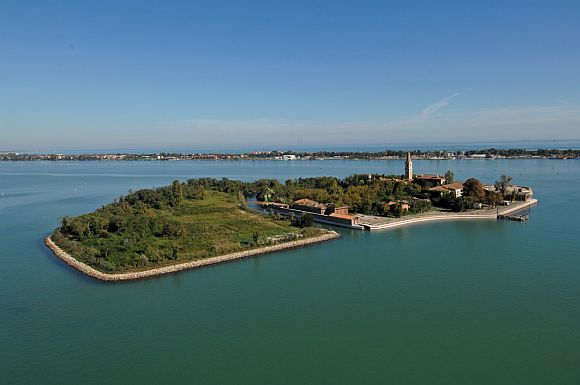
POVEGLIA: Remember the popular groundswell, funded by citizen contributions, to acquire the island and restore it for the use of the Venetians rather than let it be sold to one of those terrible foreign companies which would transform it into a hotel?
All stuck in lawyer-land. The city put the island up for bids; the highest bid, from a private businessman, was snubbed by the city as being ridiculously low. To which the bidder has replied, “But you had no higher bids in this auction. So?”
In any case, the groundswell of Venice-for-the-Venetians emotion hasn’t been heard from in quite some time, considering that since last June 4, when the sky fell on Venice, much bigger problems have overcome everybody. It would be extremely difficult, in the current climate, to get anybody excited about an abandoned island.
BIG CRUISE SHIPS: This is an issue that’s so photogenic that it cauterizes people brains, rendering them incapable of thought. In battling to ban the ships from passing in the Bacino of San Marco, the enthusiasts have created a much larger problem, which is how to keep the port economy going when some cruise lines have already canceled their plans to come to Venice in 2015.
The no-big-ships people haven’t given any sign of caring much about the port itself, but they are baffled as to how to they feel about the digging of the Contorta Canal (officially named the Canale Contorta S. Angelo). But it seems clear to almost everybody that deepening the canal will create so many more problems than it solves that it makes my teeth grind all by themselves.
The tug of war about approving the Contorta canal is going to continue for an unspecified time. Another year, anyway, I have no doubt. There will be flourishing crops of claims, counter-claims, and recriminations.
Meanwhile, due to the canceled cruises, 300,000 fewer passengers are expected this year. This means people may very well be laid off or fired, and all the rest of the ripple effect that doesn’t need describing. There is also the loss of income from the taxes paid by the ship companies to be considered. Nice.
But what I don’t understand is why the ships are vilified as ugly, and therefore deserving of death, when everyday ugliness like graffiti just keeps rolling along, singing a song.
Old? New? Is there a difference?


Probably nobody is thinking about New Year’s Eve anymore, no matter where they spent it. But here in Venice it’s not over yet, as the papers continue to publish a cascade of ever-more-detailed articles, personal stories, and editorials on how things went.
In a word: Badly.
So I’m going to back up from my earlier post and try this report again. Because in case you don’t know, the three most beautiful words in the English language are not “I love you” (though they’re not the worst, either).
Nope. The three MOST beautiful words are “You were right.” And in my case, its close cousin: “I was wrong.”
I admit that I felt uneasy writing that sunny little post about New Year’s Eve. Even as I wrote it, I had the strange feeling that I was unaccountably speaking in some unknown language from the planet where life is beautiful all the time.
I must have inadvertently disconnected my internal smoke-detector, because the news is demonstrating, in ever more lurid detail, why I will never go near the Piazza San Marco on the night of Saint Sylvester. And how inexplicably incapable the city is of organizing big events in some reasonable manner. And when I refer to the organization of big events, I have some small experience elsewhere; for example, the Fiesta of San Fermin at Pamplona, which I have attended twice. And I’d go back again, no matter how much I hate crowds, and one of many reasons is because it is organized and maintained in the most dazzlingly intelligent and diligent manner for nine solid days and nights. And a mere twelve hours drives Venice to its knees.
From 9:30 PM, rivers of young people arriving by train filled the streets heading toward the Piazza, smashing bottles and setting off firecrackers as they went.
Far from being a scene of frolic and light-hearted conviviality, as the night dragged on the Piazza San Marco (and Piazzale Roma, whence thousands tried eventually to depart the most beautiful city in the world) resembled a war zone, or a frat party of intercontinental dimensions. Words such as “assault,” “devastation,” and “outrage” highlight the reports of the night, and the morning after.
Piles of shattered glass bottles and pools of biological fluids from either or both ends of homo stupidus prostratus were only some of the abundant remains. There were also the bodies of comatose sleeping revelers scattered around the streets, lying where they fell when the fumes ran out.
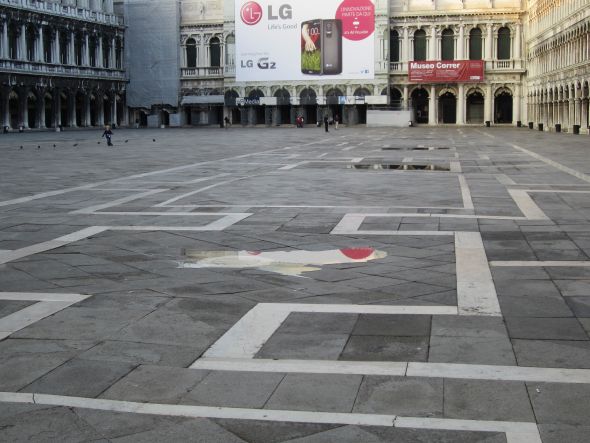
The story in figures:
80,000 partyers, 10,000 more than the past two years. Most of the yobbos weren’t Venetian, but from everywhere else — what in New York are called “bridge and tunnel” people. I’ve seen them there at the St. Patrick’s Day parade, and it’s not lovely. It’s no lovelier here.
50 interventions by the 45 emergency medical personnel from the Green Cross, Civil Protection, and SUEM, the ambulance entity; most crises related to alcohol drunk, alcohol spilled (rendering the already wet pavement dangerously slippery), cuts by the broken glass of bottles blindly hurled into the air, blows to the head, and panic attacks caused by the mob and the explosions of firecrackers at close quarters.
100,000 euros ($135,868) the estimated cost to the city, excluding fireworks. This approximate number comprises: 60,000 euros for the collection and removal of 135 cubic meters (4,732 cubic feet)of garbage, of which 20 cubic meters (706 cubic feet) were of glass; 15,000 euros for the 60 Municipal Police agents on security duty. And the cost, not yet quantified, of the extra transport personnel (50 bus drivers and an unspecified number of vaporetto pilots). And the fuel required by the 20 garbage barges.
60 extra buses coming into Venice from the mainland; 123 extra buses between midnight and 7:00 AM from Venice to the mainland. Does this sound like a lot? Au contraire; the ACTV, in its wisdom, put on extra vaporettos, which worked well, but reduced the basic number of bus runs on a holiday eve. Because it’s, you know, a holiday, and the drivers want to be at home. New Year’s Eve in Venice, with reduced bus service. Explain this to the masses of tired, cold, exasperated people who were trying to get back home, who even overwhelmed the relatively few taxis in Piazzale Roma. Explain it to anybody, if you can. And I still can’t figure out how 50 extra bus drivers were sent to work if there were fewer buses. Or were they put to work scrolling the “Out of service” sign onto the buses’ forefronts?
The story in voices:
“It was hard, if not impossible, to move. Funky air, a mix of piss and drugs, the pavement “mined” with bottles, cans, and every sort of garbage…The Piazza was a disaster. Electronic music at full volume incited the crowd that was already drunk and out of control. A great number of young people had taken over, armed with every type of alcohol…the center of the Piazza was an inferno. Not just fireworks, but young people, Italian and foreign, were competing in a new entertainment: the launching of bottles…I didn’t see any security agents that would have forbidden this behavior…The day after, the marks remained on our city, heritage of humanity, devastated by barbarism.” (Margherita Gasco)
“According to a recent international survey, the night between the last and first of the year shows Venice to be among the principal capitals of the festivities on the planet. This shouldn’t prevent us from … reflecting critically on how these events are carried out — if they’re worth the trouble, if they still have their original sense.” (Gianfranco Bettin, the assessore for the Environment).
“Such a high number of people wasn’t predicted, nor predictable,” said Angela Vettese, the assessore of Culture and Tourism Development. (It wasn’t predictable? Does she not read tourism surveys?). “In the future, more prudence is necessary to protect the Piazza, and to invest in more surveillance, so that the police can check, count, and keep access to the Piazza within a determined limit. Furthermore, it’s necessary to organize only high-quality events, with spectacles that involve the public (more involved than they already were?), maintaining greater tranquillity.” She’s still new on the job, or she wouldn’t be talking like that; all these things have been said before, and before, and even before that.
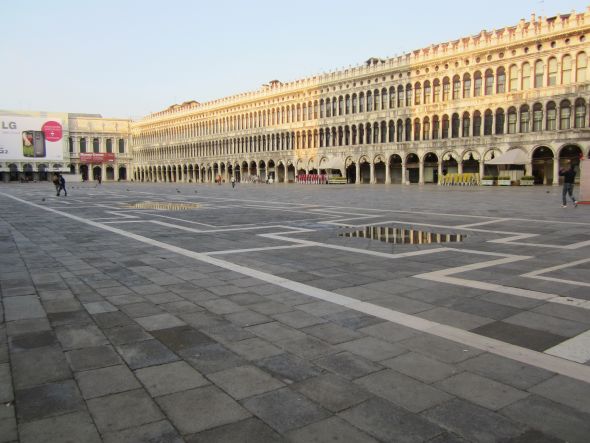
Social network comments were divided between those who think New Year’s Eve in the Piazza is the greatest thing ever, and those who think the care and protection of the already fragile city is more important; those who insist it was just a normal night of festivity, and those who characterize is as another example of sheer lunacy.
“I urge the church to make itself heard, seeing that the civil authorities don’t feel any special need to safeguard the Piazza San Marco…Can we imagine an event like last Tuesday in the Piazza San Pietro in Rome?” (Franco Miracco, art historian).
“San Marco can’t be the only stage for events” (Mons. Antonio Meneguolo, diocese of Venice). “It’s not the number of people which creates bad behavior,” he said. “We can increase the security but it would be better to organize other activities elsewhere, and remove the emphasis of the publicity for “New Year’s in the Piazza,” seeing how the event ends up.”
“Venice continues to be seen as a city to exploit touristically down to the bone,” said Lidia Fersuoch, president of Italia Nostra. “More than limit access to the Piazza, it’s necessary to limited access to the city itself, because it’s impossible to contain more than a certain number of visitors.”
“Certainly, if we take as the limit the Pink Floyd concert of 1989, anything even just barely below that is considered tolerable…But hurling bottles, explosion of firecrackers, people who urinate and vomit in the streets, are these part of the normal course of public socializing? For some people, yes, but for us, no. Especially if it happens in the Piazza San Marco, which isn’t just any piazza, but a monumental area, as it was defined when concerts were stopped (because they have an excessive impact on the Piazza itself)… But why no to concerts, and yes to New Year’s Eve? We speak of “outrage” precisely because it’s a monumental area; you can’t remain indifferent seeing people climbing up the 16th-century columns of the Loggetta of Sansovino at the feet of the campanile. The piazza has always been the place for socializing, for events. But what events?” (Davide Scalzotto)
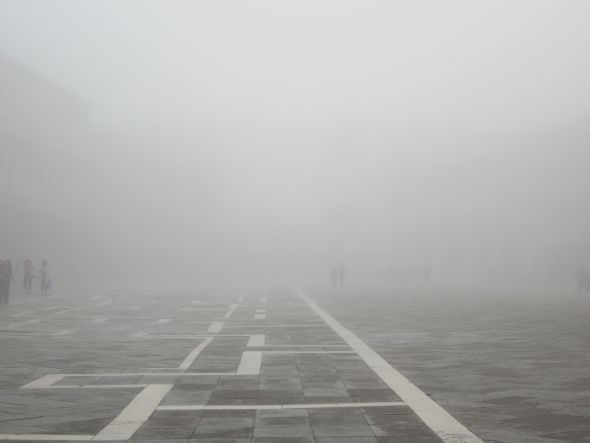
Here is what I ask myself and anyone who might be listening: There is a Superintendency of architecture, of art, of treasures. There is the Polizia di Stato, the carabinieri, the municipal police, the Guardia di Finanza. There are ordinances forbidding almost every dangerous and tumultuous form of behavior and the hazardous objects associated with them. Why is there no evident point at which any of these elements meet? The behavior and objects are at Point A, and any uniformed persons authorized to intervene are at Points Q, X, and Z. All told, there may have been more garbage collectors than anybody else at work in the Piazza, which seems backwards, to me.
In theory, if there were more agents of public order on duty, there would be less need for the First Aid stations, not to mention the ambulances and garbagemen.
But let me move on to a much more distressing thought.
Venice is a UNESCO World Heritage Site, which, unlike many of the 981 sites on their list, is a real place where real people live and move and have their being. This presents special problems which nobody seems able to anticipate, or resolve. I am at a loss to say why, except that with ten fingers per city councilor, there’s plenty for pointing at other people.
There are 49 UNESCO sites in Italy, more than any other country on earth. So far, none is marked as being “in danger.” I think Venice should be. I cannot conceive of shenanigans such as New Year’s Eve in the Piazza San Marco being tolerated in Angkor, or Machu Picchu, or the Alhambra, or the Red Fort Complex, or the Etruscan Necropolises, or the Potala Palace, or the Galapagos Islands. And this is not the first time. And yet, it goes on.
And I’ll say one more thing, as long as I’m on the subject: Of all the “properties” on UNESCO’s list of World Heritage Sites, only two, so far, have been de-listed. The reasons are given on this page of their website.
Between the catastrophes visited upon Venice under the ever-fresh rubber stamp of the Superintendency of Architectural Treasures (the tormented issue of the maxi-posters in the San Marco area has only been moderately resolved, among other things), and the continued abuse of the lagoon, which is also part of the World Heritage designation (from the Canale dei Petroli to MoSE and now to the imminent approval of the digging of the Contorta canal), I don’t think it’s inconceivable that eventually Venice could see itself de-listed from the UNESCO panoply.
This is not the most improbable scenario I’ve ever come up with. Except that I’d love to be able to say “I was wrong.”